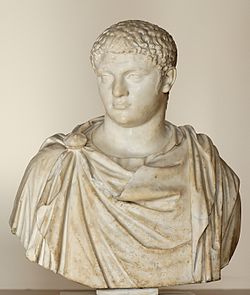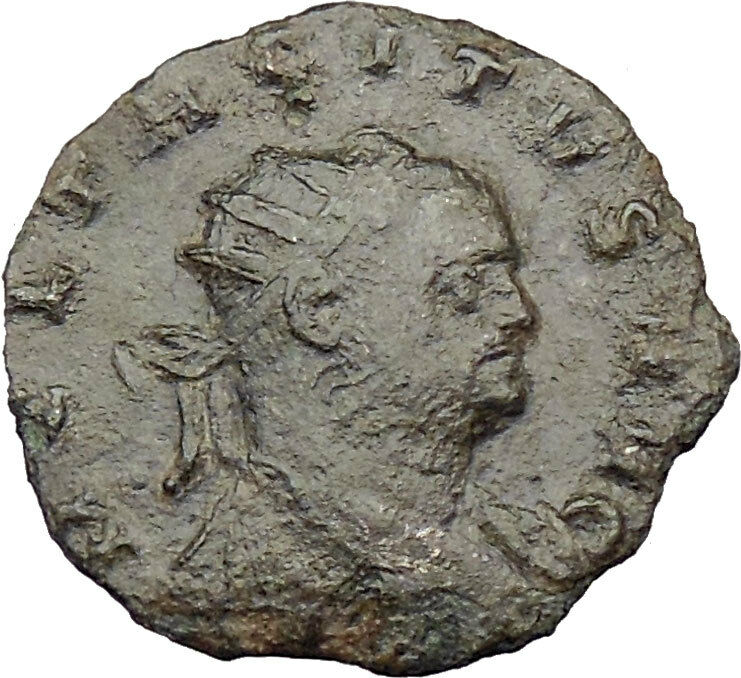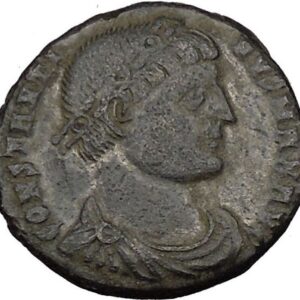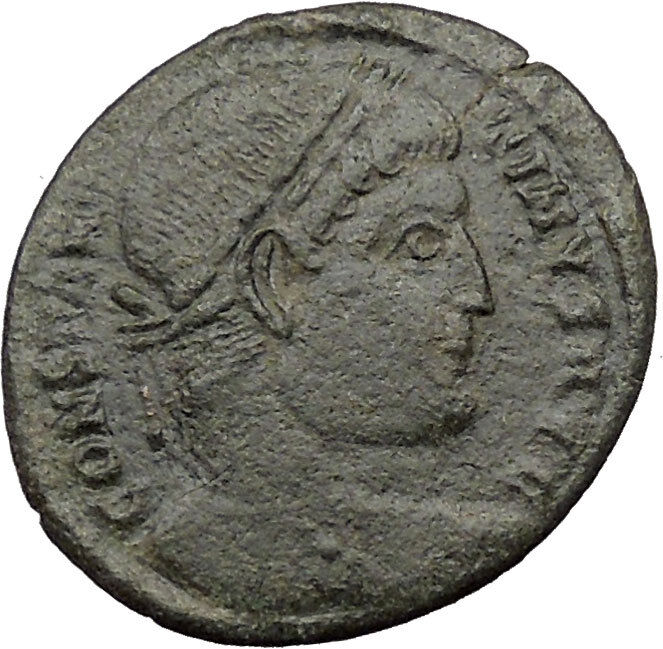|
Geta – Roman Emperor: 209-211 A.D.
Silver Denarius 19mm (3.07 grams) Rome mint: 199 A.D.
Reference: RIC 13a, BMC 223, S 7184
PSEPTGETACAESPONT – Bare-headed, draped bust right.
NOBILITAS – Nobilitas standing right, holding scepter and Palladium.
You are bidding on the exact item pictured, provided with a Certificate of Authenticity and Lifetime Guarantee of Authenticity.
 In Greek and Roman mythology, the palladium or palladion was a cult image of great antiquity on which the safety of Troy and later Rome was said to depend, the wooden statue (xoanon) of Pallas Athena that Odysseus and Diomedes stole from the citadel of Troy and which was later taken to the future site of Rome by Aeneas. The Roman story is related in Virgil’s Aeneid and other works. This statue, three cubits in height, held a lance in the right hand, a shield on the left arm. Dionysius of Halicarnassus, who follows the Grecian figment that it was the gift if heaven to the Trojans, adds that Aeneas possessed himself of it and conveyed it to Italy, with his household gods (Penates). It was said to have long been preserved in the Temple of Vesta, at Rome and many medals represent that goddess seated, with the Palladium in her hand. In Greek and Roman mythology, the palladium or palladion was a cult image of great antiquity on which the safety of Troy and later Rome was said to depend, the wooden statue (xoanon) of Pallas Athena that Odysseus and Diomedes stole from the citadel of Troy and which was later taken to the future site of Rome by Aeneas. The Roman story is related in Virgil’s Aeneid and other works. This statue, three cubits in height, held a lance in the right hand, a shield on the left arm. Dionysius of Halicarnassus, who follows the Grecian figment that it was the gift if heaven to the Trojans, adds that Aeneas possessed himself of it and conveyed it to Italy, with his household gods (Penates). It was said to have long been preserved in the Temple of Vesta, at Rome and many medals represent that goddess seated, with the Palladium in her hand.
That the Palladium was preserved in the Temple if Vesta, at Rome, is a fact considered by Eckhel, to be typified on a brass medallion of Lucilla, Empress if Lucius Verus, on which, without epigraph, appears a temple, in which is an idol and before which six female figures are sacrificing at a lighted altar. It is narrated by Val. Maximus that, at the burning of the temple of Vesta, Metellus preserved the Palladium, which was snatched unharmed from out of the midst of the conflagration. Lucan, Herodian, and Livy, confirm this statement; the last named writer says – “Quid de asternis Vestae ignibus signoque quod imperii pignus custodia ejus templi tenetur, loquar?” – [“Why need I speak of the eternal fire of Vesta, and of the statue (i.e. Palladium) which is preserved, as a pledge of the empire’s safety, in the sanctuary of her temple?”]
The Palladium borne by Aeneas in his right hand whilst he carries Anchises on his shoulders, appears on coins from the moneyers Cecilia and Julia and on denarii of Julius Caesar. – Minerva also holds it on some imperial medals – It appears in the hand of Juno, on a coin of Julia Soemias. In the hands of Vesta, it is placed, on coins of Vespasian, Titus, Domitian, Trajan, and Antonine; and also on medals of the faustinas and other Empresses. – Also in the hand of Venus, on a coin of Faustina jun. The Palladium also is seen in the right hand of the Genius or Rome, on coins of Vespasian, Domitian, Antoninus Pius and constantius Chlorus. – It also appears in the right hand of Annona, on a silver medal of Titus, as indicating the popular belief that so long as that image was preserved the Roman empire would flourish.
In English, since around 1600, the word palladium has been used figuratively to mean anything believed to provide protection or safety, and in particular in Christian contexts a sacred relic or icon believed to have a protective role in military contexts for a whole city, people or nation. Such beliefs first become prominent in the Eastern church in the period after the reign of the Byzantine Emperor Justinian I, and later spread to the Western church. Palladia were carried in procession around the walls of besieged cities and sometimes carried into battle.
 Nobilitas, Roman goddess, as the embodiment (personification) of being “noble” or having “nobility”. She is depicted on coins as a female figure standing at times with a lance in one hand and the palladium in the other. Valor in war and/or wisdom in council were ways by which nobility was or ought to be acquired. Nobilitas, Roman goddess, as the embodiment (personification) of being “noble” or having “nobility”. She is depicted on coins as a female figure standing at times with a lance in one hand and the palladium in the other. Valor in war and/or wisdom in council were ways by which nobility was or ought to be acquired.
During the Roman Republic, nobilis (“noble,” plural nobiles) was a descriptive term of social rank, usually indicating that a member of the family had achieved the consulship. Those who belonged to the hereditary patrician families were noble, but plebeians whose ancestors were consuls were also considered nobiles. The transition to nobilitas thus required the rise of an exceptional individual, who was considered a “new man” (novus homo). Two of the most famous examples of these self-made “new men” were Gaius Marius, who held the consulship seven times, and Marcus Tullius Cicero.
The Second Samnite War (326-304 BC) was a formative time in the creation of this ruling elite comprising both patricians and plebeians who had risen to power. From the mid-4th century to the early 3rd century BC, several plebeian-patrician “tickets” for the consulship repeated joint terms, suggesting a deliberate political strategy of cooperation.
Scholarly attempts to define nobilitas have led to debates over the particulars of its usage in ancient sources. Fergus Millar points out that nobilis was a descriptive word as used in the Late Republic, and not a technical term for a restricted social group in the sense of peerage. Matthias Gelzer held that the term was reserved for descendants of consuls, and therefore reckoned that Munatius Plancus, consul designate for 42, was the last man to qualify as an ancestor for a nobilis. P.A. Brunt, building on the view of Theodor Mommsen, assembled evidence of broader usage that suggests any curule office might grant the aura of nobilitas. The term is not found in the literature of the mid-Republic, and came into use long after the social and political changes that created “noble” plebeians.
During the time of Augustus, a nobilis enjoyed easier access to the consulship, with a lowered age requirement perhaps set at 32. Women who descended from Augustan consuls are also regarded as belonging to the Roman nobility. In the usage of Tacitus and Pliny Minor, a nobilis is a descendant of the Republican aristocracy. The meaning of nobilis then evolved during the Imperial period.

Geta – Roman Emperor: 209-211 A.D.
| Caesar: 198-209 A.D. (under Septimius Severus and Caracalla) | Augustus: 209-211 A.D. (209-211 with Septimius Severus and Caracalla) (211 A.D. with Caracalla) |
| Son of Septimius Severus and Julia Domna | Brother of Caracalla | Brother-in-law of Plautilla | Nephew of Julia Maesa | Cousin of Julia Soaemias and Julia Mamaea |
Publius Septimius Geta (March 7, 189-December 26, 211), was a Roman Emperor co-ruling with his father Septimius Severus and his older brother Caracalla from 209 to his death.
Geta was the younger son of Septimius Severus by his second wife Julia Domna. Geta was born in Rome, at a time when his father was only a provincial governor at the service of emperor Commodus.
Geta was always in a place secondary to his older brother Lucius, the heir known as Caracalla. Perhaps due to this, the relations between the two were difficult from their early years. Conflicts were constant and often required the mediation of their mother. To appease his youngest son, Septimius Severus gave Geta the title of Augustus in 209. During the campaign against the Britons of the early 3rd century, the imperial propaganda publicized a happy family that shared the responsibilities of rule. Caracalla was his father’s second in command, Julia Domna the trusted counsellor and Geta had administrative and bureaucratic duties. Truth was that the rivalry and antipathy between the brothers was far from being improved.
Joint Emperor
When Septimius Severus died in Eboracum in the beginning of 211, Caracalla and Geta were proclaimed joint emperors and returned to Rome.
Regardless, the shared throne was not a success: the brothers argued about every decision, from law to political appointments. Later sources speculate about the desire of the two of splitting the empire in two halves. By the end of the year, the situation was unbearable. Caracalla tried to murder Geta during the festival of Saturnalia without success. Later in December he arranged a meeting with his brother in his mother’s apartments, and had him murdered in her arms by centurions.
Following Geta’s assassination, Caracalla damned his memoryy and ordered his name to be removed from all inscriptions. The now sole emperor also took the opportunity to get rid of his political enemies, on the grounds of conspiracy with the deceased. Cassius Dio stated that around 20,000 persons of both sexes were killed and/or proscribed during this time.
|





 In Greek and Roman mythology, the palladium or palladion was a cult image of great antiquity on which the safety of Troy and later Rome was said to depend, the wooden statue (xoanon) of Pallas Athena that Odysseus and Diomedes stole from the citadel of Troy and which was later taken to the future site of Rome by Aeneas. The Roman story is related in Virgil’s Aeneid and other works. This statue, three cubits in height, held a lance in the right hand, a shield on the left arm. Dionysius of Halicarnassus, who follows the Grecian figment that it was the gift if heaven to the Trojans, adds that Aeneas possessed himself of it and conveyed it to Italy, with his household gods (Penates). It was said to have long been preserved in the Temple of Vesta, at Rome and many medals represent that goddess seated, with the Palladium in her hand.
In Greek and Roman mythology, the palladium or palladion was a cult image of great antiquity on which the safety of Troy and later Rome was said to depend, the wooden statue (xoanon) of Pallas Athena that Odysseus and Diomedes stole from the citadel of Troy and which was later taken to the future site of Rome by Aeneas. The Roman story is related in Virgil’s Aeneid and other works. This statue, three cubits in height, held a lance in the right hand, a shield on the left arm. Dionysius of Halicarnassus, who follows the Grecian figment that it was the gift if heaven to the Trojans, adds that Aeneas possessed himself of it and conveyed it to Italy, with his household gods (Penates). It was said to have long been preserved in the Temple of Vesta, at Rome and many medals represent that goddess seated, with the Palladium in her hand. Nobilitas, Roman goddess, as the embodiment (personification) of being “noble” or having “nobility”. She is depicted on coins as a female figure standing at times with a lance in one hand and the palladium in the other. Valor in war and/or wisdom in council were ways by which nobility was or ought to be acquired.
Nobilitas, Roman goddess, as the embodiment (personification) of being “noble” or having “nobility”. She is depicted on coins as a female figure standing at times with a lance in one hand and the palladium in the other. Valor in war and/or wisdom in council were ways by which nobility was or ought to be acquired.





